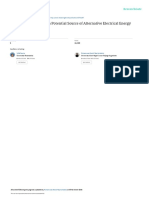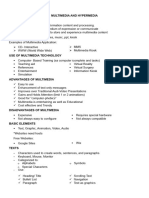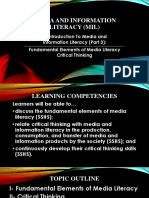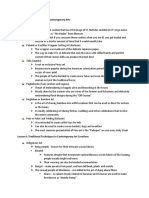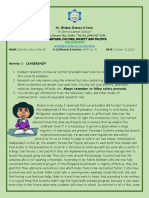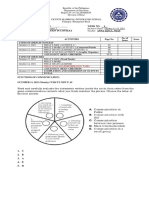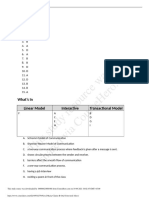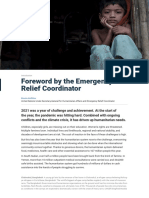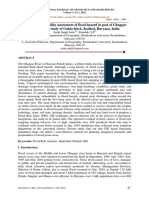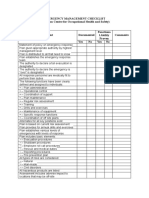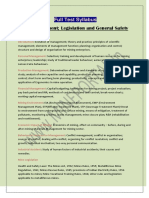Aimar
Aimar
Uploaded by
de Guzman, Yasmien M.Copyright:
Available Formats
Aimar
Aimar
Uploaded by
de Guzman, Yasmien M.Original Title
Copyright
Available Formats
Share this document
Did you find this document useful?
Is this content inappropriate?
Copyright:
Available Formats
Aimar
Aimar
Uploaded by
de Guzman, Yasmien M.Copyright:
Available Formats
4 Am I Ready?
Direction:
Suppose you are invited by the SK Chairman in your barangay as a resource
speaker to your fellow age group during an Environmental Awareness Activity
and you were asked to give emphasis on the risk factors underlying disasters so
that young people will be equipped with knowledge on how to mitigate the
effects of a disaster. Have a concept in mind of how you are going to deliver the
information. Write down what you want to deliver to the audience. The given
rubrics below will be used for scoring.
Good day! Nowadays, there are a lot of platforms and strategies that young people can addressed
this environmental awareness and gives emphasis on this risk factors underlying disasters. Also,
when dealing with disasters focused on emergency response, but it was gradually understood by
the end of the 20th century that hazards are not natural (even though the associated danger is)
and that we can avoid casualties and mitigate the impacts of disasters only by reducing and
maintaining conditions of hazard, visibility and vulnerability. We can measure disaster
probability by analyzing patterns of, for example, past catastrophe losses. These patterns will
assist us in determining if catastrophe risk reduction is successful. By doing a risk assessment,
we will also forecast potential losses. For young people to know and understand its strategic
methods underlying crisis and disasters, it has four (4) different strategies; First, Promotion it
focuses in large-scale impact through the standardization of messages such us publications
(billboards, posters), presentation, audio visual materials, web pages and social media. The
messages live on by volunteers (scouts, college students, etc.) who continue to deliver key
messages through live interactions such as school visits and also this program is one of the key
concepts in addressing environmental awareness activity.; Second, learning by doing: "focuses
on involving young people by using a situation to find challenges and ways to solve them." A
situation that can be tailored to age and skill is used for this form of problem-based learning
(PBL). Mistakes are permitted and there are some changes in the analysis of the data, which can
be carried out in a second scenario. Some research-based methods are used, such as risk and
vulnerability analysis and evaluation of capability, planning and implementation measures.;
Third, Informal education: relies on short lectures / meetings to promote thinking and involve
young people in defining challenges and finding suitable action to develop a broader viewpoint.;
Fourth, Formal education: Reflects on the implementation and integration into school curricula
of disaster management and risk mitigation. The responsibility for the problem (school safety in
this context) and the program lies solely with the educational authorities, which will require
local, regional and national funding for long-term planning and capacity-building. So, Inorder for
individuals to keep you and your family safe during a disaster, being prepared and have safety
tips can prevent injuries at all times and make a difference in an emergency: You need to stay
informed, tuning to local authorities for information about evacuation and safety tips. Have a
plan for evacuation, you need to know where you will go during a natural disaster and how will
you get there. Keep emergency kits on hand, stock kits with flashlights, batteries, first aid
supplies, and Important identification details. Avoid unnecessary risk, do not leave your home
unless instructed to do so. And lastly, Go to the safest area in your home. So be prepared and Be
Safe! Thank you. <3333
This study source was downloaded by 100000824668468 from CourseHero.com on 03-04-2022 08:48:46 GMT -06:00
https://www.coursehero.com/file/72055385/AIMARdocx/
Powered by TCPDF (www.tcpdf.org)
You might also like
- Midwest Food Bank: Strategic Plan ProposalDocument24 pagesMidwest Food Bank: Strategic Plan Proposalclarisa herediaNo ratings yet
- 77 ArticleText 153 1 10 20190722Document9 pages77 ArticleText 153 1 10 20190722Syril Gabrielle BelaguinNo ratings yet
- What'S More: Activity 1. Present Me!Document5 pagesWhat'S More: Activity 1. Present Me!Ethan Miles Vigilancia100% (1)
- The Effect of Soil PH On The Stomatal Density of Tradescantia SpathaceaDocument13 pagesThe Effect of Soil PH On The Stomatal Density of Tradescantia SpathaceaAnnelyn Ruth SucayanNo ratings yet
- Future Value and Present Value Solving ProblemsDocument2 pagesFuture Value and Present Value Solving ProblemsPam G.100% (1)
- LESSON 3 Contemporary ArtsDocument10 pagesLESSON 3 Contemporary ArtsJana Beni Carolyn R. SabadoNo ratings yet
- MIL Q3 M3 Evolution-of-MediaDocument30 pagesMIL Q3 M3 Evolution-of-MediaMariamae EsmeraldaNo ratings yet
- Activity 3 - Engagement - Text StructureDocument2 pagesActivity 3 - Engagement - Text StructureNayre JunmarNo ratings yet
- Lesson 1 Media and Information LiteracyDocument9 pagesLesson 1 Media and Information LiteracyGabriel PatronNo ratings yet
- A MIL Q1M6 Teacher Copy Final LayoutDocument24 pagesA MIL Q1M6 Teacher Copy Final LayoutNikki Olegario Fernandez100% (1)
- Grade 12 Small Ruminants Quarter 1 2 LRDocument27 pagesGrade 12 Small Ruminants Quarter 1 2 LRreliza serranoNo ratings yet
- Graduation Purposes emDocument27 pagesGraduation Purposes emAlexia IglisanNo ratings yet
- Practical Research 2, Quarter 2: Week 1Document9 pagesPractical Research 2, Quarter 2: Week 1Aira Manuba MozoNo ratings yet
- Presentation 1Document18 pagesPresentation 1Mark Joseph MabugayNo ratings yet
- This Study Resource Was: Pre-TestDocument3 pagesThis Study Resource Was: Pre-Testpotchi devsNo ratings yet
- Activity On Understanding - AnsDocument6 pagesActivity On Understanding - AnsLeila EnolpeNo ratings yet
- Lesson 5 UcspDocument15 pagesLesson 5 UcspElvie ColladoNo ratings yet
- Activity 1. Imagine That You Own An Advertising Firm, You Need To Create A Brochure ForDocument7 pagesActivity 1. Imagine That You Own An Advertising Firm, You Need To Create A Brochure ForallenNo ratings yet
- Module 1Document4 pagesModule 1Florens Genoves BagatNo ratings yet
- Computer Science ReviewerDocument4 pagesComputer Science ReviewerAvril RegalaNo ratings yet
- Misconceptions of EntrepDocument29 pagesMisconceptions of EntrepRhea BadanaNo ratings yet
- MODULE 6 - THE LAWS OF PHYSICS-WPS OfficeDocument5 pagesMODULE 6 - THE LAWS OF PHYSICS-WPS OfficePsychopompNo ratings yet
- Practical Research 1.1Document7 pagesPractical Research 1.1Mary graceNo ratings yet
- Philo of Man CapSLET LC 2.3Document12 pagesPhilo of Man CapSLET LC 2.3JD Jamolod-PelovelloNo ratings yet
- Thesis StatementsDocument30 pagesThesis StatementsHarlequin Doctolero100% (1)
- Gabriela: Angel Is A Humanitarian Through and Through. She's A Human Rights Activist, A ProudDocument1 pageGabriela: Angel Is A Humanitarian Through and Through. She's A Human Rights Activist, A ProudRONALD ARTILLERO100% (1)
- UntitledDocument20 pagesUntitledPrecia AldayNo ratings yet
- Mil Q3W6Document14 pagesMil Q3W6Alexa RomarateNo ratings yet
- Learning Activity Sheet in 3is (Inquiries, Investigation, Immersion)Document7 pagesLearning Activity Sheet in 3is (Inquiries, Investigation, Immersion)Roselyn Relacion LucidoNo ratings yet
- Media and Information Literacy (Mil)Document32 pagesMedia and Information Literacy (Mil)Karel De La TorreNo ratings yet
- Physical Education & Health 11: Health Risk in Our LifestyleDocument87 pagesPhysical Education & Health 11: Health Risk in Our LifestyleClarence RagmacNo ratings yet
- Contemporary Arts 12 Q4 WK 5Document13 pagesContemporary Arts 12 Q4 WK 5Kapas TickNo ratings yet
- Sets FITT Goals: Module 1-Lesson 3Document3 pagesSets FITT Goals: Module 1-Lesson 3Chum VergaraNo ratings yet
- Contemporary ArtsDocument4 pagesContemporary ArtsShendy AcostaNo ratings yet
- Evaluating Websites A Checklist - JOHN CARLO G. GAERLANDocument3 pagesEvaluating Websites A Checklist - JOHN CARLO G. GAERLANMarvin CincoNo ratings yet
- Active Video Games Helps Some Kids Get Active by Jennifer WarnerDocument2 pagesActive Video Games Helps Some Kids Get Active by Jennifer WarnerAdexentrix WPNo ratings yet
- Questions by Coming Up With Answers About Real Things and Asking "Why?"Document5 pagesQuestions by Coming Up With Answers About Real Things and Asking "Why?"Kinect Nueva EcijaNo ratings yet
- Englishforacademic - Quarter 1 Module 1Document27 pagesEnglishforacademic - Quarter 1 Module 1Stephanie AriasNo ratings yet
- 12 Francis Bacon Functions of Education in Society: Learning Activity 1Document5 pages12 Francis Bacon Functions of Education in Society: Learning Activity 1jessamae gundanNo ratings yet
- Summary Module 2 P.E 3Document2 pagesSummary Module 2 P.E 3Lamanilao Calubag Eludo JoiceanneNo ratings yet
- Activity 1Document2 pagesActivity 1ERL GODFRE P. NICOL80% (5)
- Philosophcial Tools and ProcessesDocument28 pagesPhilosophcial Tools and ProcessesJoanna PacoNo ratings yet
- Media Information TechnologyDocument8 pagesMedia Information Technologyarmand100% (1)
- DRRR Q2 Module13 Juliet-C.-baduyaDocument20 pagesDRRR Q2 Module13 Juliet-C.-baduyaJillian SibayanNo ratings yet
- Department of Education: Empowerment Technologies Module 1 - Answer SheetDocument3 pagesDepartment of Education: Empowerment Technologies Module 1 - Answer SheetJAYNo ratings yet
- English For Academic and Professional Purposes Nov. 30-Dec 4Document5 pagesEnglish For Academic and Professional Purposes Nov. 30-Dec 4Princess Lynn Aquino PaduaNo ratings yet
- MIL 7... Grade 12 BezosDocument6 pagesMIL 7... Grade 12 Bezosadrian lozanoNo ratings yet
- PracticalresearchDocument26 pagesPracticalresearchEinsteinAng-og, Claire Y.No ratings yet
- Concept PaperDocument3 pagesConcept PaperVincent Troa CarandangNo ratings yet
- Worksheet in ETECH Grade 11Document4 pagesWorksheet in ETECH Grade 11Cristian Dominic EscarlanNo ratings yet
- Act4 Ucsp Alissa JularbalDocument4 pagesAct4 Ucsp Alissa JularbalAlissa MayNo ratings yet
- EAPP, Canapati John Francis B.Document18 pagesEAPP, Canapati John Francis B.John Francis CanapatiNo ratings yet
- Week 4 Occ Learning Activity SheetDocument8 pagesWeek 4 Occ Learning Activity SheetAngelynne Bagaconza MirabelNo ratings yet
- Introduction To Media and Information LiteracyDocument24 pagesIntroduction To Media and Information LiteracyLerah MahusayNo ratings yet
- Entreprenuership: Ej Faith Tabia ABM 12-CDocument11 pagesEntreprenuership: Ej Faith Tabia ABM 12-CErica Faye JometanoNo ratings yet
- Philo of Man CapSLET LC 3.1Document12 pagesPhilo of Man CapSLET LC 3.1AlexNo ratings yet
- The Nature of Academic TextsDocument44 pagesThe Nature of Academic TextsJenine LegaspiNo ratings yet
- PR2 - SLHT 1 - January 4 To 8Document5 pagesPR2 - SLHT 1 - January 4 To 8JESSA SUMAYANGNo ratings yet
- Mil Module 8&9Document5 pagesMil Module 8&9Kia Khyte FloresNo ratings yet
- CLAIMSDocument2 pagesCLAIMSVersoza NelNo ratings yet
- DRRR QUARTER 2 Week 4 - A4Document2 pagesDRRR QUARTER 2 Week 4 - A4Jana Mae Catot AcabalNo ratings yet
- DRRR Hand Out 15Document5 pagesDRRR Hand Out 15Angela CadanoNo ratings yet
- Activity 4 de Guzman Yasmien M.Document4 pagesActivity 4 de Guzman Yasmien M.de Guzman, Yasmien M.No ratings yet
- Activity 4 - de Guzman, Yasmien M.Document3 pagesActivity 4 - de Guzman, Yasmien M.de Guzman, Yasmien M.No ratings yet
- Marketing PlanDocument58 pagesMarketing Plande Guzman, Yasmien M.No ratings yet
- Activity 2 DRRRDocument4 pagesActivity 2 DRRRde Guzman, Yasmien M.No ratings yet
- Naval Maria Clarins B. Oral Com Mod 3Document9 pagesNaval Maria Clarins B. Oral Com Mod 3de Guzman, Yasmien M.No ratings yet
- PMnL2030 Urgency-GAM-CGSODocument72 pagesPMnL2030 Urgency-GAM-CGSODianne BalogbogNo ratings yet
- N Final Report Undp HrvaDocument156 pagesN Final Report Undp HrvaAbhisek DasguptaNo ratings yet
- Executive SummaryDocument27 pagesExecutive Summaryrmateo_caniyasNo ratings yet
- Barangay San Antonio - Eo 1 - 2024 - Creating The Barangay Disaster Risk Reduction Management CommitteeDocument6 pagesBarangay San Antonio - Eo 1 - 2024 - Creating The Barangay Disaster Risk Reduction Management CommitteeDanilo T. NacuaNo ratings yet
- Senior Airport Operations Agent 08Document4 pagesSenior Airport Operations Agent 08kpall99No ratings yet
- Undertaking Day Scholar - Updatedjuly15 - 2021Document2 pagesUndertaking Day Scholar - Updatedjuly15 - 2021Sandy DisuzaNo ratings yet
- RISE Riverine Challenge OverviewDocument15 pagesRISE Riverine Challenge OverviewMr DesignNo ratings yet
- Emergency Fire Procedures IIDocument20 pagesEmergency Fire Procedures IICarla ElguiraNo ratings yet
- Pids DP On NDRRMCDocument52 pagesPids DP On NDRRMCPhilip Jude Acidre100% (1)
- Soalan Penilaian Berterusan AK21703Document4 pagesSoalan Penilaian Berterusan AK21703Abd JoeNo ratings yet
- Global Humanitarian Overview 2022 (Introduction)Document15 pagesGlobal Humanitarian Overview 2022 (Introduction)zeeshanNo ratings yet
- SLK DRRR q2 Week 8Document18 pagesSLK DRRR q2 Week 8KENNEDY VAGAY100% (1)
- Ghaggar River Flood AssessmentDocument13 pagesGhaggar River Flood Assessmentvaibhav_nautiyalNo ratings yet
- Dobcel Duty of Care Supervision of Students Policy and Procedures 1Document11 pagesDobcel Duty of Care Supervision of Students Policy and Procedures 1api-211088946No ratings yet
- The New Concept in Civil FieldDocument15 pagesThe New Concept in Civil FieldNaveen Kumar KaddsNo ratings yet
- DRRR ReportDocument50 pagesDRRR ReportSTAR CHINEMA100% (1)
- Emergency Management ChecklistDocument4 pagesEmergency Management ChecklistRogerr KurniaNo ratings yet
- Group Link Whatsapp - StudentDocument6 pagesGroup Link Whatsapp - StudentaqyanNo ratings yet
- SHS-DRRR - MODULE 1 - Concept and Nature of DisasterDocument20 pagesSHS-DRRR - MODULE 1 - Concept and Nature of Disasterhahajr80No ratings yet
- Terrorism Mass Casualty Disaster NursingDocument3 pagesTerrorism Mass Casualty Disaster NursingJUDE MARIANO JR. ALBANCES CARLOSNo ratings yet
- Pengetahuan Tank Terminal RiskDocument8 pagesPengetahuan Tank Terminal RiskdikdikNo ratings yet
- Emergency Response r2Document77 pagesEmergency Response r2shyamNo ratings yet
- Brgy Disaster Readiness ChecklistDocument4 pagesBrgy Disaster Readiness ChecklistGhia PornillosNo ratings yet
- Shanica: Health, Safety, Security and Environmental Management SystemDocument35 pagesShanica: Health, Safety, Security and Environmental Management SystemSunday Augustine ChibuzoNo ratings yet
- Mine Mangement Legilation & General SafetyDocument2 pagesMine Mangement Legilation & General Safetypradeep dawer100% (1)
- PPT M6 Airport Emergency Planning Procedure-2020Document41 pagesPPT M6 Airport Emergency Planning Procedure-2020Fadil Satrio PamungkasNo ratings yet
- ONG Industry Preparedness Handbook v2Document36 pagesONG Industry Preparedness Handbook v2Yaya AdebisiNo ratings yet
- Ecol AssignDocument10 pagesEcol AssignChristian HaoNo ratings yet

